Instruction
The Science of Square: Understanding the relationship between the wrist and club face
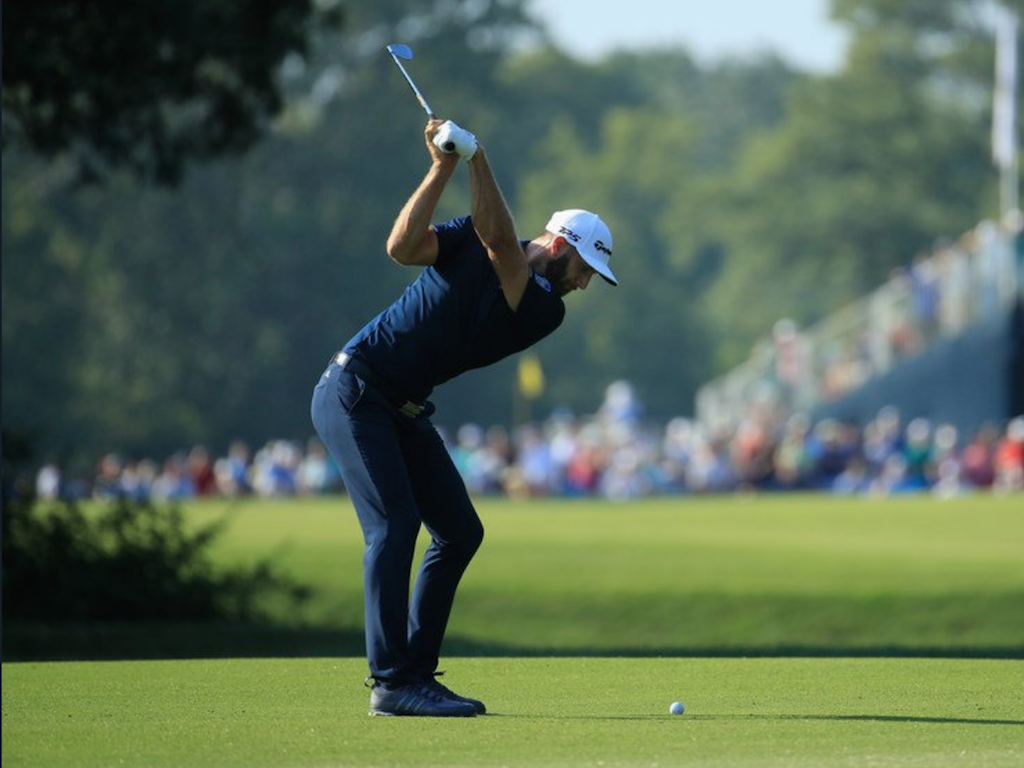
One of the biggest problems I see in today’s weekend golfer is an out-of-position clubface at the top of the swing. Understanding the articulations of the lead wrist at the address position versus at the top is crucial for you to get the face into a square position. In this article, I want you to truly understand how the grip and the top position work in conjunction with one another.
NOTE: In an upcoming article, we’ll discover why many teachers are now advocating a shut face at the top, and why they focus on getting their more serious golfers into this position. It does have several advantages for the better player, but as usual, it has limitations.
First, in this article, let’s show you the two basic left hand grips you will find in use today.
Strong grip, cupped wrist
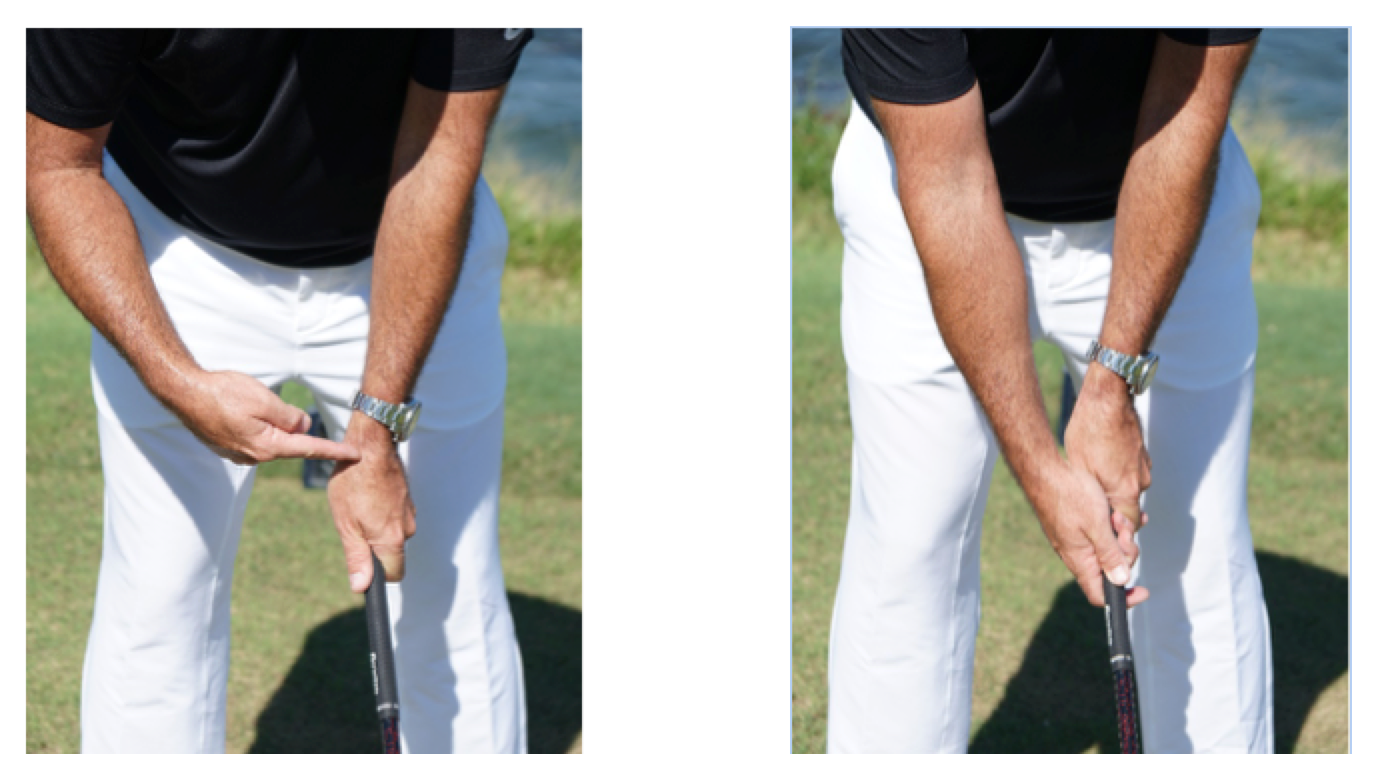
The most popular grip today is one where the lead hand is rotated away from the target at address, showing several knuckles, which produces a big cup in the lead wrist at address as shown above. This is termed a stronger grip, and the cup you see in the photos above is referred to as “extension.”
Weaker grip, flatter wrist
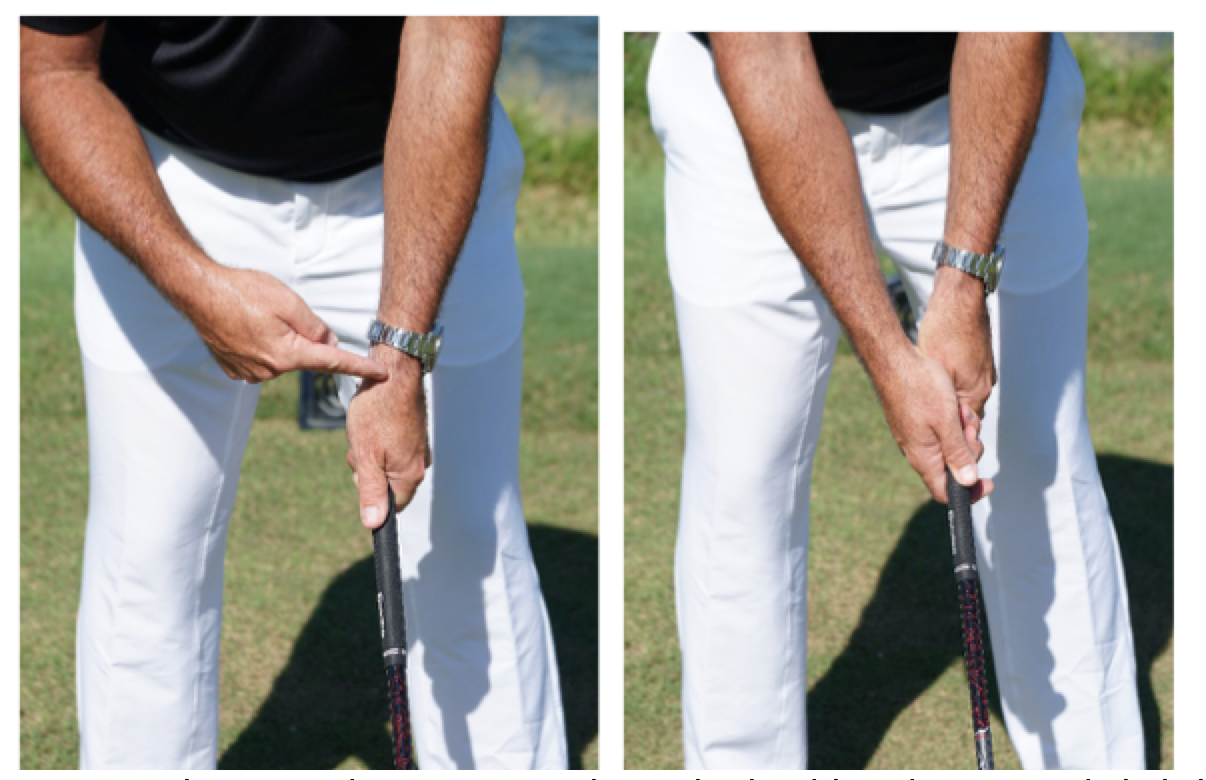
The second grip is one where the lead hand is rotated slightly away from the target at address, showing 1-to-1.5 knuckles, which produces only a slight cup in the lead wrist at address as shown above. This is termed a weaker grip.
Now that you understand the two most common grips, you also need to understand how these grips control the face at the top.
Using Hack Motion Wrist Sensor, I am now going to measure how the lead wrist works to the top. Please only focus on the first number on the screen showing extension (cupping) of the lead wrist.
With a left hand grip that is less “cuppy” at address (or “weaker”), you will see that there is little extension if any at address, only 8 degrees. Therefore, if the club is square at address and you keep that same amount of flexion to the top, your clubface will stay in a square condition.
Address (weak grip)
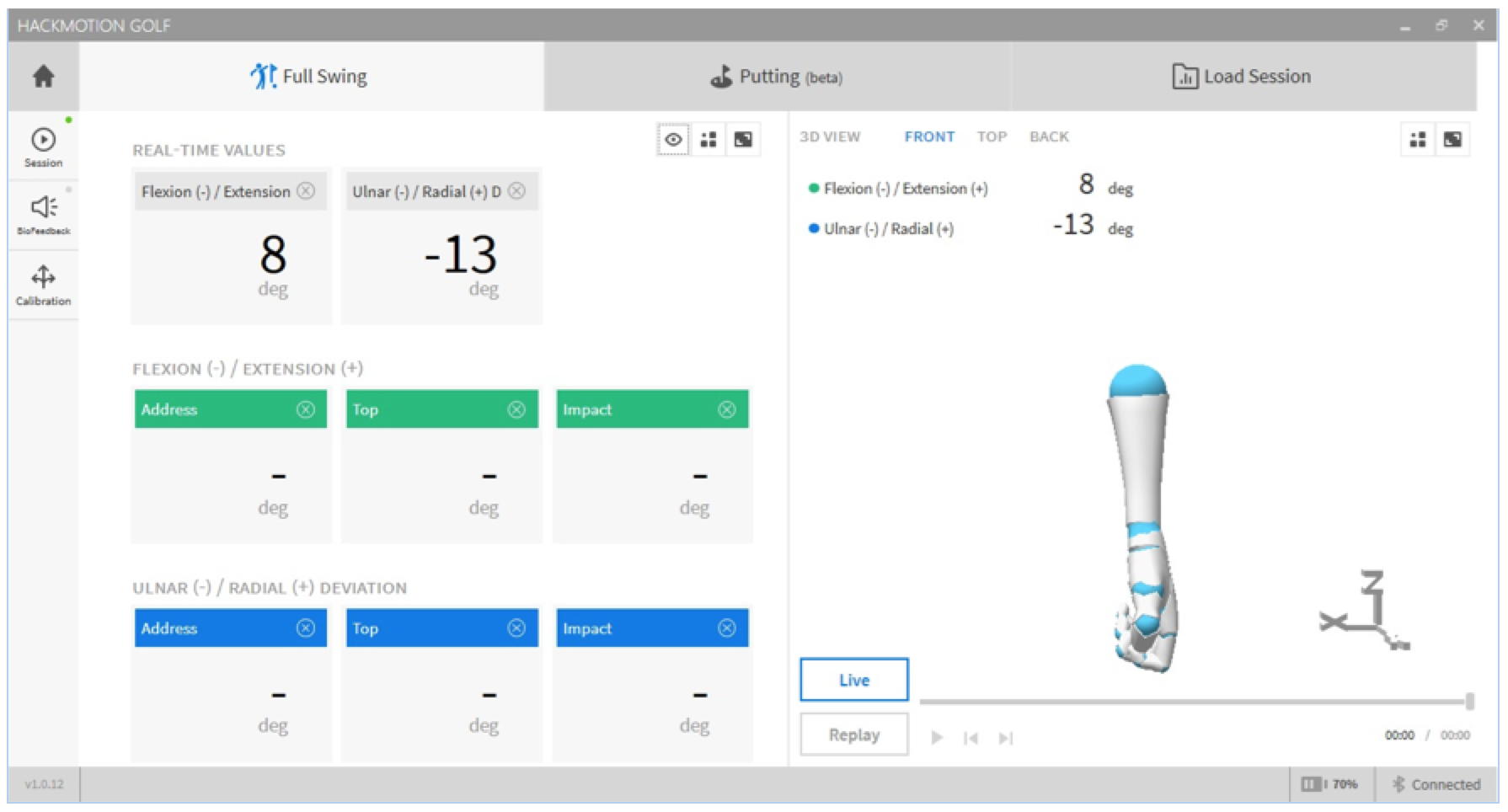
Top of Backswing (weak grip)
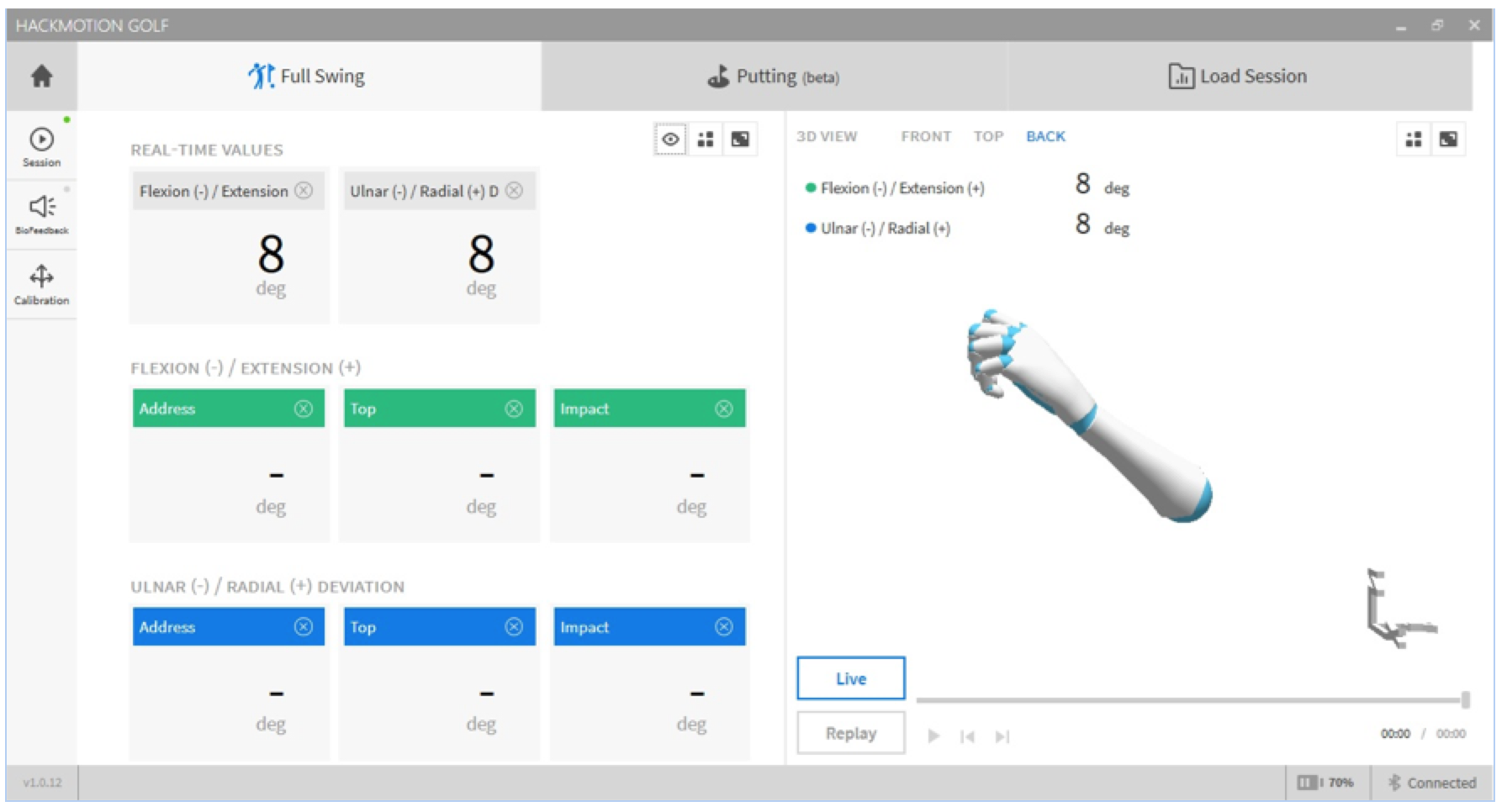
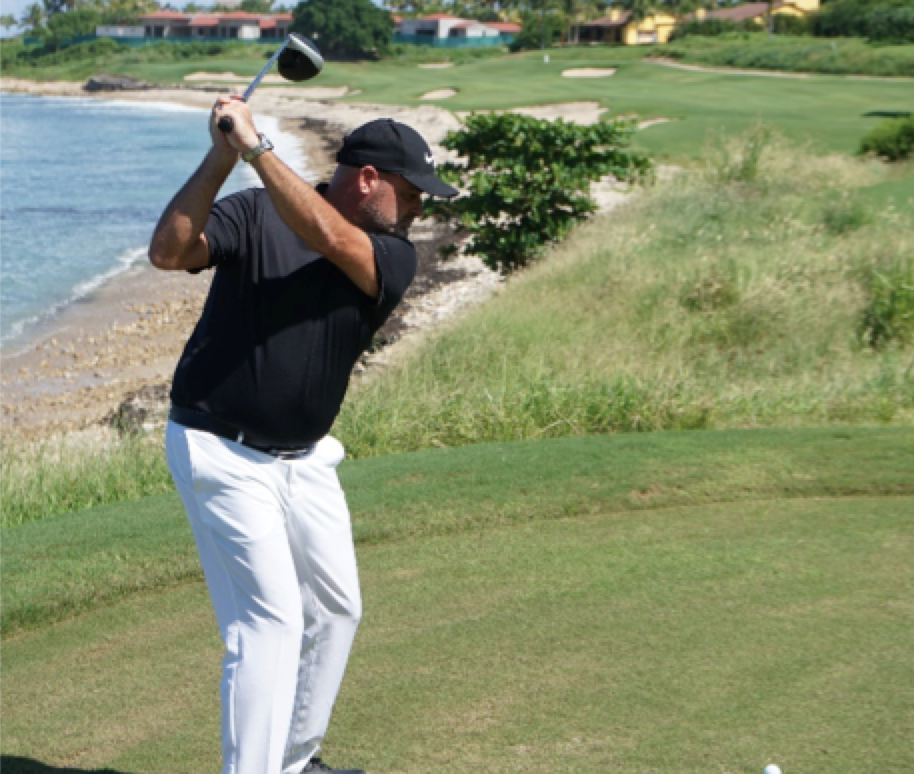
So as you can see, if I keep the lead wrist in the same condition that it started at address, then I will have the face in a square condition at the top!
Ok, so what about today’s stronger grip, or players with a more flexed lead wrist?
Address (strong grip)
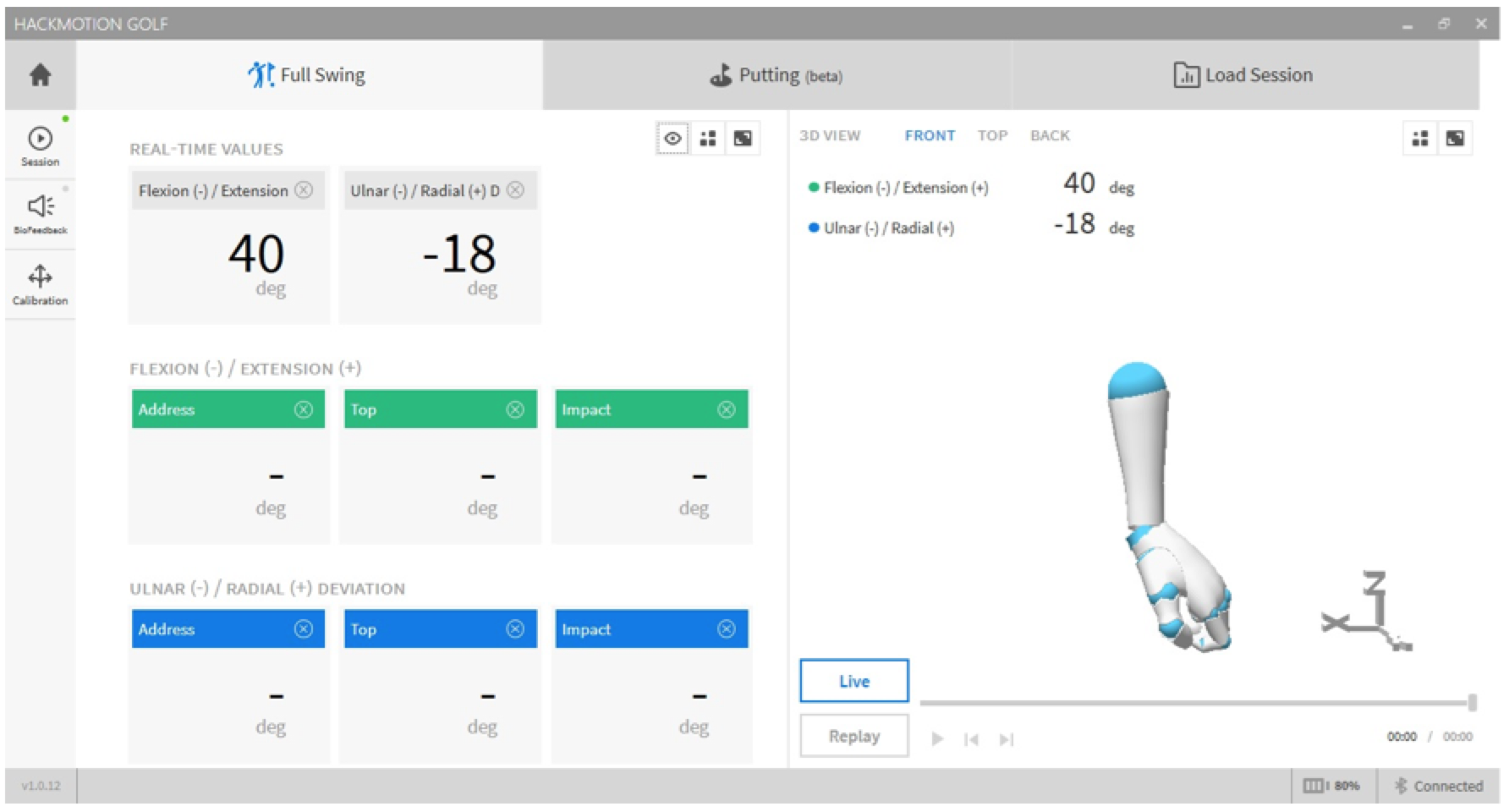
Here you see the stronger grip position with more knuckles showing in the lead hand producing 40 degrees of extension at address. Will the face be square if we keep that same amount to the top?
Top of Backswing (strong grip)
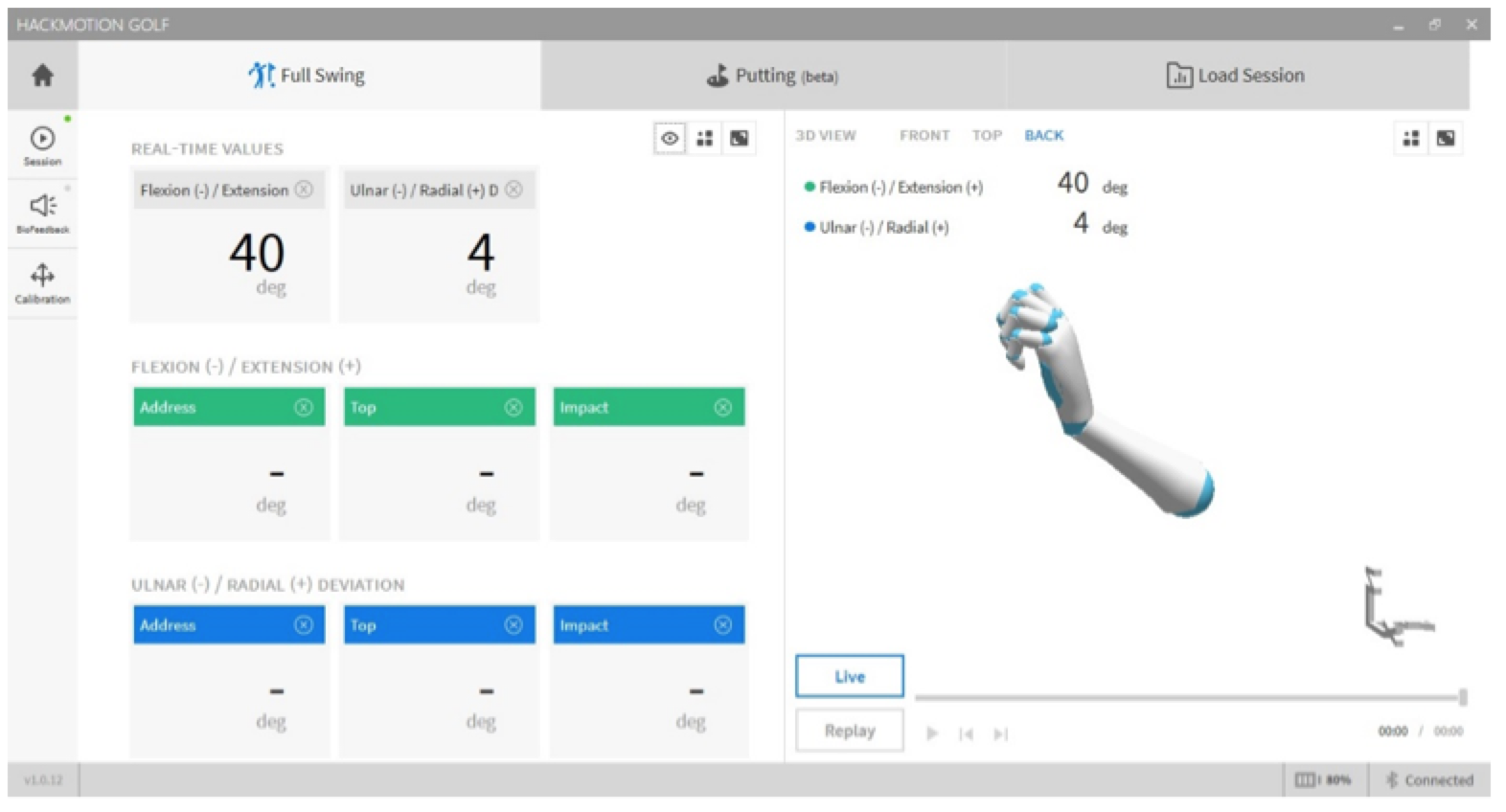
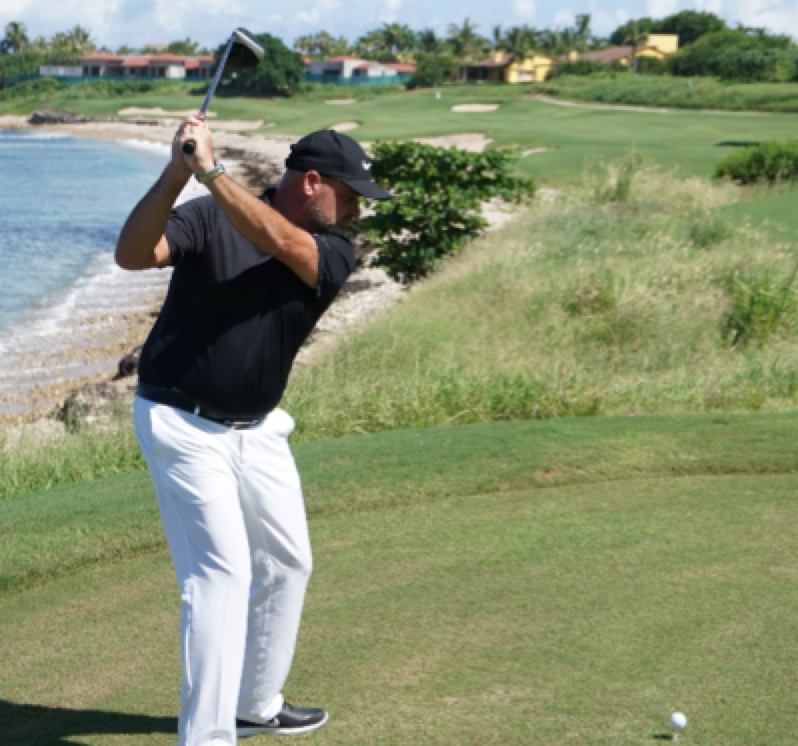
Of course! As you might have expected, the face above is square at the top, but only because the lead wrist is cupped the exact same amount at address it is at the top.
Therefore, in order to have a clubface that is square at the top, you must keep the lead wrist condition (extension) constant from the address position all the way to the top. If you interchange them, then you will have a clubface that is out of position, and you’ll have a hard time getting the ball to go where you want.
So, there’s my introduction to the wrist-clubface relationship. Look out for my next article where I analyze why bowed wrist players (think Dustin Johnson or Brooks Koepka) are finding success.
- LIKE118
- LEGIT25
- WOW9
- LOL3
- IDHT2
- FLOP7
- OB7
- SHANK65
Instruction
The Wedge Guy: The easiest-to-learn golf basic

My golf learning began with this simple fact – if you don’t have a fundamentally sound hold on the golf club, it is practically impossible for your body to execute a fundamentally sound golf swing. I’m still a big believer that the golf swing is much easier to execute if you begin with the proper hold on the club.
As you might imagine, I come into contact with hundreds of golfers of all skill levels. And it is very rare to see a good player with a bad hold on the golf club. There are some exceptions, for sure, but they are very few and very far between, and they typically have beat so many balls with their poor grip that they’ve found a way to work around it.
The reality of biophysics is that the body moves only in certain ways – and the particulars of the way you hold the golf club can totally prevent a sound swing motion that allows the club to release properly through the impact zone. The wonderful thing is that anyone can learn how to put a fundamentally sound hold on the golf club, and you can practice it anywhere your hands are not otherwise engaged, like watching TV or just sitting and relaxing.
Whether you prefer an overlap, interlock or full-finger (not baseball!) grip on the club, the same fundamentals apply. Here are the major grip faults I see most often, in the order of the frequency:
Mis-aligned hands
By this I mean that the palms of the two hands are not parallel to each other. Too many golfers have a weak left hand and strong right, or vice versa. The easiest way to learn how to hold the club with your palms aligned properly is to grip a plain wooden ruler or yardstick. It forces the hands to align properly and shows you how that feels. If you grip and re-grip a yardstick several times, then grip a club, you’ll see that the learning curve is almost immediate.
The position of the grip in the upper/left hand
I also observe many golfers who have the butt of the grip too far into the heel pad of the upper hand (the left hand for right-handed players). It’s amazing how much easier it is to release the club through the ball if even 1/4-1/2″ of the butt is beyond the left heel pad. Try this yourself to see what I mean. Swing the club freely with just your left hand and notice the difference in its release from when you hold it at the end of the grip, versus gripping down even a half inch.
To help you really understand how this works, go to the range and hit shots with your five-iron gripped down a full inch to make the club the same length as your seven-iron. You will probably see an amazing shot shape difference, and likely not see as much distance loss as you would expect.
Too much lower (right) hand on the club
It seems like almost all golfers of 8-10 handicap or higher have the club too far into the palm of the lower hand, because that feels “good” if you are trying to control the path of the clubhead to the ball. But the golf swing is not an effort to hit at the ball – it is a swing of the club. The proper hold on the club has the grip underneath the pad at the base of the fingers. This will likely feel “weak” to you — like you cannot control the club like that. EXACTLY. You should not be trying to control the club with your lower/master hand.
Gripping too tightly
Nearly all golfers hold the club too tightly, which tenses up the forearms and prevents a proper release of the club through impact. In order for the club to move back and through properly, you must feel that the club is controlled by the last three fingers of the upper hand, and the middle two fingers of the lower hand. If you engage your thumbs and forefingers in “holding” the club, the result will almost always be a grip that is too tight. Try this for yourself. Hold the club in your upper hand only, and squeeze firmly with just the last three fingers, with the forefinger and thumb off the club entirely. You have good control, but your forearms are not tense. Then begin to squeeze down with your thumb and forefinger and observe the tensing of the entire forearm. This is the way we are made, so the key to preventing tenseness in the arms is to hold the club very lightly with the “pinchers” — the thumbs and forefingers.
So, those are what I believe are the four fundamentals of a good grip. Anyone can learn them in their home or office very quickly. There is no easier way to improve your ball striking consistency and add distance than giving more attention to the way you hold the golf club.
More from the Wedge Guy
- The Wedge Guy: Golf mastery begins with your wedge game
- The Wedge Guy: Why golf is 20 times harder than brain surgery
- The Wedge Guy: Musings on the golf ball rollback
- LIKE85
- LEGIT13
- WOW6
- LOL1
- IDHT0
- FLOP4
- OB1
- SHANK8
Instruction
Clement: Stop ripping off your swing with this drill!

Not the dreaded headcover under the armpit drill! As if your body is defective and can’t function by itself! Have you seen how incredible the human machine is with all the incredible feats of agility all kinds of athletes are accomplishing? You think your body is so defective (the good Lord is laughing his head off at you) that it needs a headcover tucked under the armpit so you can swing like T-Rex?
- LIKE0
- LEGIT2
- WOW2
- LOL0
- IDHT0
- FLOP0
- OB0
- SHANK2
Instruction
How a towel can fix your golf swing

This is a classic drill that has been used for decades. However, the world of marketed training aids has grown so much during that time that this simple practice has been virtually forgotten. Because why teach people how to play golf using everyday items when you can create and sell a product that reinforces the same thing? Nevertheless, I am here to give you helpful advice without running to the nearest Edwin Watts or adding something to your Amazon cart.
For the “scoring clubs,” having a solid connection between the arms and body during the swing, especially through impact, is paramount to creating long-lasting consistency. And keeping that connection throughout the swing helps rotate the shoulders more to generate more power to help you hit it farther. So, how does this drill work, and what will your game benefit from it? Well, let’s get into it.
Setup
You can use this for basic chip shots up to complete swings. I use this with every club in my bag, up to a 9 or 8-iron. It’s natural to create incrementally more separation between the arms and body as you progress up the set. So doing this with a high iron or a wood is not recommended.
While you set up to hit a ball, simply tuck the towel underneath both armpits. The length of the towel will determine how tight it will be across your chest but don’t make it so loose that it gets in the way of your vision. After both sides are tucked, make some focused swings, keeping both arms firmly connected to the body during the backswing and follow through. (Note: It’s normal to lose connection on your lead arm during your finishing pose.) When you’re ready, put a ball in the way of those swings and get to work.

Get a Better Shoulder Turn
Many of us struggle to have proper shoulder rotation in our golf swing, especially during long layoffs. Making a swing that is all arms and no shoulders is a surefire way to have less control with wedges and less distance with full swings. Notice how I can get in a similar-looking position in both 60° wedge photos. However, one is weak and uncontrollable, while the other is strong and connected. One allows me to use my larger muscles to create my swing, and one doesn’t. The follow-through is another critical point where having a good connection, as well as solid shoulder rotation, is a must. This drill is great for those who tend to have a “chicken wing” form in their lead arm, which happens when it becomes separated from the body through impact.
In full swings, getting your shoulders to rotate in your golf swing is a great way to reinforce proper weight distribution. If your swing is all arms, it’s much harder to get your weight to naturally shift to the inside part of your trail foot in the backswing. Sure, you could make the mistake of “sliding” to get weight on your back foot, but that doesn’t fix the issue. You must turn into your trial leg to generate power. Additionally, look at the difference in separation between my hands and my head in the 8-iron examples. The green picture has more separation and has my hands lower. This will help me lessen my angle of attack and make it easier to hit the inside part of the golf ball, rather than the over-the-top move that the other picture produces.


Stay Better Connected in the Backswing
When you don’t keep everything in your upper body working as one, getting to a good spot at the top of your swing is very hard to do. It would take impeccable timing along with great hand-eye coordination to hit quality shots with any sort of regularity if the arms are working separately from the body.
Notice in the red pictures of both my 60-degree wedge and 8-iron how high my hands are and the fact you can clearly see my shoulder through the gap in my arms. That has happened because the right arm, just above my elbow, has become totally disconnected from my body. That separation causes me to lift my hands as well as lose some of the extension in my left arm. This has been corrected in the green pictures by using this drill to reinforce that connection. It will also make you focus on keeping the lead arm close to your body as well. Because the moment either one loses that relationship, the towel falls.


Conclusion
I have been diligent this year in finding a few drills that target some of the issues that plague my golf game; either by simply forgetting fundamental things or by coming to terms with the faults that have bitten me my whole career. I have found that having a few drills to fall back on to reinforce certain feelings helps me find my game a little easier, and the “towel drill” is most definitely one of them.
- LIKE12
- LEGIT2
- WOW2
- LOL0
- IDHT0
- FLOP2
- OB0
- SHANK8
-

 19th Hole1 week ago
19th Hole1 week agoDave Portnoy places monstrous outright bet for the 2024 Masters
-

 19th Hole2 weeks ago
19th Hole2 weeks agoThings got heated at the Houston Open between Tony Finau and Alejandro Tosti. Here’s why
-

 19th Hole1 week ago
19th Hole1 week agoTiger Woods arrives at 2024 Masters equipped with a putter that may surprise you
-

 19th Hole2 weeks ago
19th Hole2 weeks agoReport: Tiger Woods has ‘eliminated sex’ in preparation for the 2024 Masters
-

 19th Hole3 days ago
19th Hole3 days agoTwo star names reportedly blanked Jon Rahm all week at the Masters
-

 19th Hole3 days ago
19th Hole3 days agoNeal Shipley presser ends in awkward fashion after reporter claims Tiger handed him note on 8th fairway
-

 19th Hole2 weeks ago
19th Hole2 weeks agoAddiction, spinal fusion, and scam artists – Everything Anthony Kim revealed in candid interview with David Feherty
-

 19th Hole2 days ago
19th Hole2 days agoReport: LIV Golf identifies latest star name they hope to sign to breakaway tour



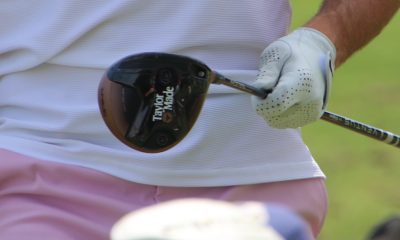

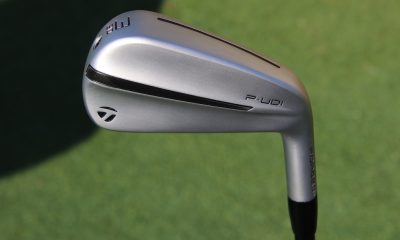





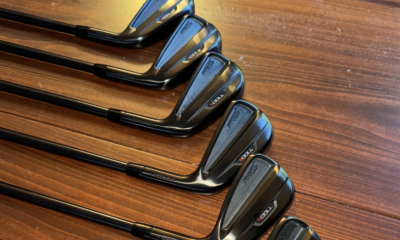













Rusty Trombeauner
Sep 12, 2018 at 1:27 am
Tom, i’m Lovin’ this wrist action discussion, good stuff. Seriously, keep it coming. Same to you awesome guys in the comments section, woohoo!
Ray Bennett
Sep 7, 2018 at 5:02 am
My understanding of square,open, closed clubface at the top of the backswing is the relationship of the leading edge of the clubface to the lead forearm (ulnar bone) just before transition to the downswing. Closed is still open to the swing plane line just less open than square and open. In the modern tour swing closed is the new square because there is less supination of the target wrist to square the clubface before impact with minimum rotation of the face through impact.
Jeremy
Sep 5, 2018 at 9:45 pm
I thought DJ’s wrist position at the top of his backswing should normally result in a draw but he in fact hits a fade. It’s the wrist position at the top of the backswing in relationship to where it is at address that causes the fade (in conjunction with his swing path?)
stevet
Sep 5, 2018 at 2:57 pm
Tom has provided us with irrefutable scientific data that explains how the hand position and wrist release functions in the backswing to the top of the swing. Personal opinions are scientifically worthless. Let’s wait for the next article on the downswing.
Linwood
Sep 4, 2018 at 10:40 pm
this was confusing. As a really crummy, inexperienced player, it confused me as to how the heck I should position my wrist.
Jake
Sep 5, 2018 at 3:05 am
Ignore this advice according to the writer the number one player in the world has an out of position wrist.
Go figure.
stevet
Sep 5, 2018 at 2:49 pm
A little bit of knowledge is dangerous in the mindlets of incompetent golfers. Tom is sharing knowledge that is significant to other instructors, not crummy golfers like you who are confused continually. Get lessons.
Jake
Sep 4, 2018 at 2:38 am
No such thing as an out of position at the top.If you are coming into impact clubface facing target then your position is good.Its advice such as this which keeps golfers on a backfoot and no improvement in their golf.
stevet
Sep 5, 2018 at 2:53 pm
So what straightens out the clubface to the target at impact? A super game improvement club design… or how you hold and release your wrists?
Brad
Sep 3, 2018 at 4:05 pm
Has the Hack Motion Wrist Sensor been useful in your golf lessons for recreational golfers?
Tom F. Stickney II
Sep 3, 2018 at 11:47 pm
Certainly…the auditory biofeedback is a game changer.
stevet
Sep 4, 2018 at 1:25 am
Auditory biofeedback must be more effective than verbal instruction. The golfer has something other than their ‘feel’ to confirm their actions.
Shifty
Sep 2, 2018 at 6:35 am
If only someone could shed light on this. I’m forever going between strong and weak. Strong ends up in hooks and weak is straight but looses a lot of distance compared.
Tom F. Stickney II
Sep 3, 2018 at 9:09 am
It’s because of your path being too far left at impact
geohogan
Sep 3, 2018 at 8:02 pm
What George Knudson said about the lead wrist and the golf swing:
“I noticed every player who struck the ball well maintained the same firmness in the left wrist at the completion of the swing as was established in the Starting Position. The wrists don’t break down, as Tommy Bolt called flippy-wristed kids stuff.
“I had no idea that to maintain firm wrists was to properly use my legs. I ignored footwork also because I was stuck on golf’s number one misconception … keep the head still. I later learned that the head has to go where the body carries it. The head has nothing to do with the golf swing, the head has no purpose in the swing”
stevet
Sep 3, 2018 at 10:39 pm
Hogan had a cupped lead wrist at the top of the swing and used pronation to flatten the wrist into impact.
stevet
Sep 4, 2018 at 1:20 am
Your head is a counter-balance weight that stabilizes your shoulder rotation velocity vector axis.
Ray Bennett
Sep 7, 2018 at 4:49 am
Hogan supinated his left forearm early in the downswing and bowed (flexed) his wrist with ulna deviation (thumb down) prior to impact. His left forearm then pronated past impact to the finish.
stevet
Sep 1, 2018 at 7:33 pm
If your wrist is cupped at the top it must go flat in final release and impact for full swings. I hope Tom, in his next article, will explain the function of the trail hand in the backswing for flat and cupped lead hand. Thanks.
Tom F. Stickney II
Sep 2, 2018 at 10:45 pm
Certainly sir. Thx.
Brad
Sep 3, 2018 at 4:02 pm
Looking forward to your next informative article to tie everything together. You got the back swing, now the down swing through impact. Eager for your next installment.
PG
Sep 1, 2018 at 6:33 pm
How are there so many “shank” votes? This is pretty good.
TomTaylor
Sep 3, 2018 at 11:27 pm
Agreed; definitely good stuff.
As for your first question; it has to do with gossipy pointless articles written on this site that started popping up about 2 years ago. I won’t name authors but these articles are nothing more than click-bait and have drawn tons of kooks onto what used to be a site for serious golfers.
unoho
Sep 4, 2018 at 1:18 am
I came to this forum about a year ago and posted valid critical comments about golf club designs. I was hounded off by forum moderator(s) protecting gear heads and their fantasy WITB delusions.